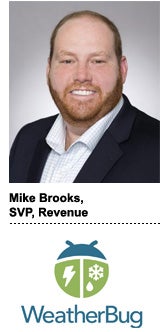Mike Brooks, WeatherBug’s SVP of revenue, is a mobile programmatic evangelist.
“We’ve seen a huge positive impact from adopting a unified auction, and we like to be vocal about it,” Brooks said. “We talk about programmatic to anybody who will listen, because this is the way of the future.”
In early 2018, the weather app, which is owned by location data company GroundTruth (previously xAd), started to migrate away from the waterfall toward a unified auction setup with help from its mobile ad exchange, InMobi. WeatherBug eventually removed six SDKs from its app, which reduced latency and improved CPMs.
Brooks also controls how WeatherBug spends its marketing budget, giving him insight into how growth connects with retention and monetization. The team structure is also starting to de-silo.
“We have a meeting every two weeks with the entire team – everyone from finance to marketing, even engineering,” Brooks said. “You can be a lot smarter about how you invest if there’s a feedback loop.”
AdExchanger spoke with Brooks about why ad networks are still so pervasive in the app ecosystem, WeatherBug’s revenue diversification strategy and the imminent death of location data in the bidstream.
AdExchanger: Will 2020 finally be the year of in-app bidding?
MIKE BROOKS: I really hope so. It’s the way to make the most money out of what you have.
The challenge with mobile is the stratification that monetization people have to deal with. We mostly use in-app bidding for mobile in-app display, and that’s been easy to transition to. But mobile video and rewarded video are less advantaged by in-app bidding, although we’re getting there.
What’s interesting to me is that in-app bidding isn’t a secret anymore, and yet so many apps still make most of their money with ad networks.
Why the prolonged love affair between apps and their ad networks, despite fraud, a lack of transparency and other issues?
It’s because people are comfortable with it. Ad networks in mobile lasted much longer than they should have because Facebook came along and people just got so used to buying that way. The demand side is already moving off of the ad network model, but the supply side is lagging.
There’s also the problem that some executives are essentially being compensated on fraud and aren’t incentivized to see what the real bottom line is.
But I’m lucky in my role, because I get to see where we spend money and where we make it, almost like a CRO and a CMO combined. That bridge doesn’t exist at most companies. The user acquisition buyers aren’t talking to the monetization folks.
How much of WeatherBug’s business is programmatic today?
Around a year and a half ago, between 80-85% of our topline revenue was programmatic, along with a small subscription business and some partnerships. Today, we’re very focused on revenue diversification. Overall revenue and CPMs from programmatic are up, but the entire revenue pie has also gotten bigger, because we’re looking to make money and grow outside of our historical channels. So, although programmatic is growing, it’s now more like 60-65% of the total business.
What sort of partnerships are you working on?
One recent partnership we’re doing is with Arity, which is a mobile data and driving analytics subsidiary of Allstate.
On an opt-in-only basis, people can track their commute to and from work, and Arity gives them advice and safety information, like, “There’s going to be a storm during your normal commute, maybe you want to consider leaving earlier or avoiding this or that road?”
This is an example of first-party data sets – location, weather, driving information – coming together as a way to build something that actually helps consumers.
You’ve got access to weather data, of course. How do you use it, and what other data do you have access to?
The honest answer is that we need to do a better job with our first-party data. We don’t currently use a CDP, for example, and we should. Beyond weather data, and I’m speaking on behalf of WeatherBug, not GroundTruth, we don’t do a lot with location data beyond weather.
What’s great about weather data is that it’s not that personal. People opt in with us, because they want to know what the weather is where they are, and then there’s the opportunity for a brand that sells cold drinks to reach them if the temperature is high.
Are we about to see a huge contraction in the amount of location data available for targeting with privacy laws coming into force, combined with increased sensitivity about location data in particular?
We are going to see the vast pools of what I might call “dark” location [data], that we’ve all been fighting against for years, start to dry up. You won’t be able to buy the garbage people have been used to buying anymore, and that’s a good thing.
At the same time, though, the value of opted-in location data goes way up. We have a direct conversation with users to say, “Hey, we want to know where you are right now so we can tell you the weather and maybe show you ads based on where you are.” That’s still a small part of our business, but the opportunity is there.
So, bye-bye bidstream location data? Eventually, at least.
If you’re a mobile website or app pulling location data in the background and you shouldn’t have been doing that – that’s over. People are going to want to know where data is coming from. They’ll want a nameable source, or nothing at all.
This interview has been edited and condensed.













